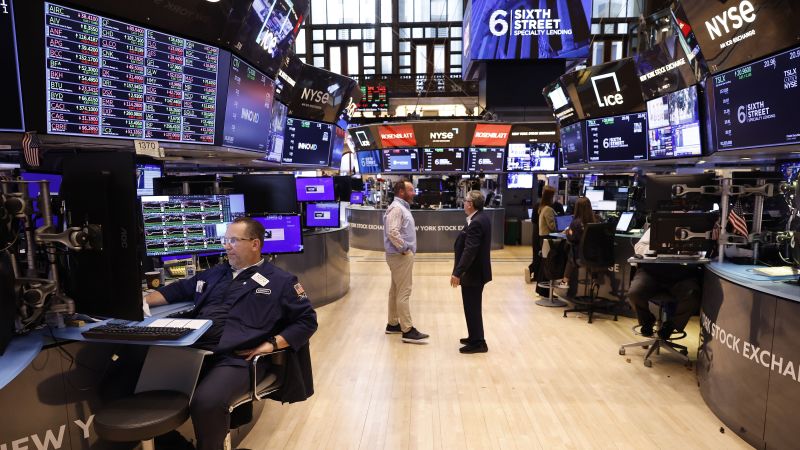A version of this story first appeared in CNN Business’ Before the Bell newsletter. Not a subscriber? You can sign up right here. You can listen to an audio version of the newsletter by clicking the same link.
It’s “sell in May and go away” season. Not everyone is jumping on the bandwagon.
The Wall Street maxim, popularized by The Stock Trader’s Almanac, suggests investors should sell their equity holdings this month and re-enter the market in November, based on the historical tendency of stocks to underperform between May and October compared with the November to April period.
Some investors might be tempted to gut their holdings after a bruising April. All three major indexes broke five-month winning streaks as hotter-than-expected inflation data stoked fears that interest rate cuts will come later than forecast. The Dow Jones Industrial Average index fell 5% in April, logging its worst month since September 2022. The S&P 500 and Nasdaq Composite declined 4.2% and 4.4%, respectively.
One trading session into May, the market has continued to struggle. Stocks on Wednesday gave up most of their gains after initially surging when Federal Reserve Chair Jerome Powell said that policymakers were unlikely to hike rates again. The central bank kept interest rates on hold at a 23-year high at its policy meeting.
But some traders warn that attempting to time the market seldom works and that the “sell in May” adage is outdated.
“Blowing out of your portfolio before the summer starts is not a recipe for success. Even with all the perils you could list we are facing, that isn’t any different than any point of time in our history,” wrote Alex McGrath, chief investment officer for NorthEnd Private Wealth, in a Monday note.
One sticking point for Wall Street? Persistent inflation has kept long-anticipated rate cuts on the backburner. Traders now expect the Fed to cut rates once or twice in 2024, after expecting as many as six cuts earlier this year, according to the CME FedWatch Tool.
But investors say that far-off rate cuts are far from a death knell for stocks. The economy has stayed robust despite one softer-than-expected GDP reading. Consumers are continuing to spend, the labor market remains solid and companies have reported robust earnings growth.
“Although Fed rate cuts may be delayed, if the economy and consumer stay strong, early rate cuts should not be necessary,” wrote Larry Tentarelli, chief technical strategist at Blue Chip Daily Trend Report, in a Tuesday note.
While some on Wall Street also fear that stocks could see more volatility closer to election day in November, stocks have historically rallied during the summer in presidential election years. The S&P 500 rose 2.3% on average during the May to October period during election years and was higher 77.8% of the time, according to Carson Group data going back to 1950.
Still, some stocks have tended to perform better than others during the year’s hotter months. The S&P 500’s consumer staples and health care sectors have climbed 4.1% on average during the May to October timeframe since 1990, outperforming the broader market’s 2.1% advance, according to CFRA Research.
The Federal Reserve said Wednesday it is holding interest rates at their current levels, as hotter-than-expected inflation data continues to push back the timing of the first rate cut, reports my colleague Bryan Mena.
Fed officials have kept their benchmark lending rate at a 23-year high since July, after aggressively raising rates starting two years ago.
Officials have said they need to have enough confidence that inflation is under control before lowering borrowing costs, but the latest figures show “there has been a lack of further progress,” according to their latest policy statement.
The Fed also announced Wednesday it is easing its grip on the economy by shrinking its massive multitrillion-dollar balance sheet at a slower pace. The central bank’s main tool is its key interest rate, but it also uses its balance sheet to either help stimulate or slow the economy, and it’s been doing the latter to fight inflation.
Starting in June, the Fed will let up to $25 billion in Treasuries from its portfolio mature each month without replacing them, down from $60 billion a month currently.
Read more here.
Tesla has abruptly fired the team running its electric vehicle charging business, raising doubts about the future of one of the largest US charging networks, which other carmakers, such as General Motors and Ford, have said they will also use.
In social media posts Tuesday, several Tesla employees confirmed the layoffs, first reported by The Information.
Tesla “has let our entire charging org go,” William Navarro Jameson, strategic charging programs lead at Tesla, wrote on X.
In a post on LinkedIn, Lane Chaplin, a senior manager in Tesla’s charging division, wrote: “In the middle of the night, I learned, along with all my #Tesla Global #Charging colleagues, the Tesla Charging org is no more.”
A lack of charging infrastructure is one of the main barriers to widespread EV adoption, and Tesla’s extensive “Supercharger” network has long been a major selling point for its vehicles, report my colleagues Hanna Ziady and Peter Valdes-Dapena.
Until recently, that network could only be used by Tesla vehicles.
Read more here.
Read the full article here




